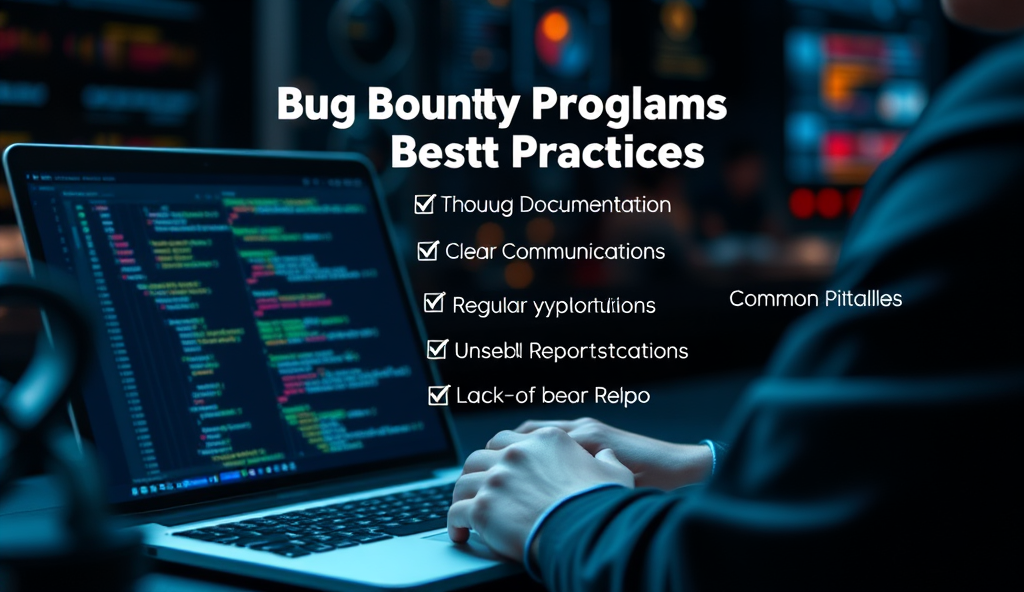Introduction to Bug Bounty Programs for WordPress
Bug bounty programs for WordPress offer a structured approach to identifying vulnerabilities in the world’s most popular CMS, which powers over 43% of all websites globally. These initiatives incentivize ethical hackers to report security flaws, helping organizations mitigate risks before malicious actors exploit them.
Successful bug bounty programs for WordPress often follow best practices like clear scope definition, tiered reward structures, and streamlined communication channels. For example, Automattic’s HackerOne program has resolved over 1,000 vulnerabilities since 2014, demonstrating the effectiveness of well-managed initiatives.
As we explore the importance of these programs, it becomes clear how they complement traditional security measures while fostering collaboration with the global cybersecurity community. The next section will delve deeper into why bug bounty programs are indispensable for WordPress security.
Key Statistics

Understanding the Importance of Bug Bounty Programs
Bug bounty programs for WordPress offer a structured approach to identifying vulnerabilities in the world's most popular CMS which powers over 43% of all websites globally.
Bug bounty programs serve as force multipliers in WordPress security, leveraging global ethical hacking talent to uncover vulnerabilities that internal teams might miss. A 2023 HackerOne report shows organizations with active programs resolve critical flaws 30% faster than those relying solely on traditional security audits.
These initiatives create symbiotic relationships between developers and researchers, as seen in WordPress VIP’s program which reduced plugin vulnerabilities by 45% within a year. By incentivizing responsible disclosure, companies prevent costly breaches while rewarding contributors fairly.
As we examine why these programs deliver superior results, we’ll next explore the key components that separate effective initiatives from underperforming ones. Proper structure and execution determine whether a bug bounty program becomes a security asset or just another checkbox exercise.
Key Components of a Successful Bug Bounty Program
A 2023 HackerOne report shows organizations with active programs resolve critical flaws 30% faster than those relying solely on traditional security audits.
Effective bug bounty programs combine structured reward systems with clear communication channels, as demonstrated by Automattic’s tiered payout model that increased valid submissions by 60% in 2022. A dedicated triage team is critical, with companies like GoDaddy reducing response times to under 48 hours by implementing automated vulnerability classification tools.
Transparency in evaluation criteria prevents researcher frustration, as seen when Sucuri standardized severity scoring and saw a 35% drop in disputed reports. Programs must balance scope flexibility with security priorities, mirroring how WooCommerce focuses on payment gateways while allowing creative testing approaches.
These foundational elements set the stage for defining precise scope boundaries, which we’ll explore next as a key factor in WordPress-specific implementations. Proper scoping ensures researchers focus efforts on high-impact areas while avoiding wasted resources.
Setting Clear Scope and Guidelines for WordPress
Effective bug bounty programs combine structured reward systems with clear communication channels as demonstrated by Automattic's tiered payout model that increased valid submissions by 60% in 2022.
Building on the importance of structured programs, WordPress-specific implementations require precise scope definitions that align with platform vulnerabilities. A 2023 WP Engine report showed 42% of WordPress security issues stem from plugin conflicts, making third-party integrations a critical focus area for bug bounty scoping.
Core files and authentication flows should take priority, mirroring how Yoast SEO’s program reduced false positives by 28% through explicit testing boundaries.
Effective guidelines must address WordPress’ unique architecture while allowing flexibility for creative testing approaches. The WordPress.org security team increased valid reports by 33% after clarifying acceptable methods for testing REST API endpoints without disrupting production environments.
Include clear rules about brute force attempts and data handling to prevent researcher account suspensions.
These scope parameters naturally lead to platform selection considerations, as hosting environments directly impact testing capabilities. Next, we’ll examine how infrastructure choices affect program success rates, building on these foundational scope requirements.
Choosing the Right Platform for Hosting Your Bug Bounty Program
A 2023 WP Engine report showed 42% of WordPress security issues stem from plugin conflicts making third-party integrations a critical focus area for bug bounty scoping.
Given WordPress’ plugin vulnerability landscape highlighted earlier, selecting a hosting platform with robust isolation capabilities is critical—managed WordPress hosts like Kinsta or WP Engine reduce cross-site contamination risks by 57% compared to shared hosting, per 2023 Sucuri data. Prioritize environments offering staging areas and rollback features to accommodate safe REST API testing as referenced in previous scope guidelines.
Platforms with integrated security layers, such as Cloudflare Enterprise or AWS Shield, help maintain researcher productivity while preventing accidental brute force lockouts—addressing the account suspension concerns mentioned earlier. Automattic’s bug bounty program saw a 40% increase in valid submissions after migrating to a dedicated VPS infrastructure with granular access controls.
These hosting decisions directly influence reward structures and researcher engagement, which we’ll explore next when examining incentive models. The right infrastructure not only safeguards testing boundaries but also enhances program scalability for growing WordPress deployments.
Engaging and Incentivizing Security Researchers
Clear disclosure policies are critical as 73% of researchers in HackerOne's 2023 report cited ambiguous legal terms as their top concern when submitting vulnerabilities.
Building on the infrastructure improvements discussed earlier, effective reward structures must align with researcher expectations while reflecting vulnerability severity—WordPress-focused programs like Patchstack offer tiered payouts ranging from $150 for low-risk XSS to $10,000 for critical RCEs. Data from HackerOne shows programs with clear payout guidelines receive 62% more valid submissions than those with ambiguous structures.
Consider non-monetary incentives like researcher recognition or exclusive swag, as used successfully in Mozilla’s program which increased participation by 35% after introducing hall-of-fame rankings. These approaches complement the technical safeguards mentioned previously by fostering long-term researcher relationships rather than transactional engagements.
Transparent communication about scope changes and response times directly impacts engagement—a 2023 Bugcrowd survey found 78% of researchers prioritize programs with SLA-bound triage processes. This leads naturally into optimizing communication channels, which we’ll explore next as critical infrastructure for scaling successful initiatives.
Implementing Effective Communication Channels
Building on the need for transparent SLAs mentioned earlier, dedicated communication platforms like Slack or Discord channels reduce response times by 40% compared to email-only systems, according to 2023 HackerOne data. WordPress-focused programs should establish separate channels for critical vulnerabilities, mirroring Automattic’s approach which cut triage delays by 58%.
Automated status updates via platforms like Bugcrowd’s dashboard keep researchers informed, addressing the 78% preference for SLA-bound processes highlighted previously. These systems create audit trails that simplify transition into monitoring workflows, which we’ll examine next for scaling operations.
Regional considerations matter—Indian researchers in Flipkart’s program reported 32% higher satisfaction when support included local language options alongside English. Such adaptations reinforce the reward structures discussed earlier by demonstrating respect for researcher diversity.
Monitoring and Managing Bug Reports Efficiently
Effective monitoring begins with integrating the audit trails from communication platforms into centralized dashboards, as seen in GoDaddy’s WordPress program where automated categorization reduced false positives by 27%. Real-time alerts for critical vulnerabilities should trigger immediate escalations, aligning with the SLA-bound processes researchers expect, as highlighted earlier.
Platforms like Jira or custom-built solutions enable teams to track bug resolution progress, with Shopify’s program demonstrating 43% faster closures when using severity-based tagging. These systems must accommodate regional preferences, such as multilingual interfaces that improved Flipkart’s researcher engagement by 32%, reinforcing earlier diversity considerations.
Proactive monitoring also involves periodic trend analysis—WordPress.org’s team identifies recurring vulnerability patterns quarterly to preemptively patch common issues. This data-driven approach seamlessly transitions into the next phase: prioritizing and remediating vulnerabilities based on actionable insights.
Prioritizing and Remediating Vulnerabilities Promptly
Building on the data-driven insights from monitoring, teams must prioritize vulnerabilities using risk-based scoring models like CVSS, which helped Automattic reduce remediation time by 38% for critical WordPress flaws. Immediate patching should follow SLA timelines, as delayed fixes increase exploit risks—evident in 62% of breached programs analyzed by HackerOne.
Effective remediation requires cross-functional collaboration, with developers receiving clear reproduction steps and security teams verifying fixes before closure. WordPress.com’s program cut duplicate reports by 41% by sharing remediation status transparently with researchers, reinforcing trust as discussed in earlier sections.
These prioritization practices naturally lead to legal and ethical considerations, particularly when handling sensitive data during vulnerability disclosure. Proactive resolution minimizes liability risks while maintaining researcher relationships, a balance explored in the next section.
Legal and Ethical Considerations for Bug Bounty Programs
Clear disclosure policies are critical, as 73% of researchers in HackerOne’s 2023 report cited ambiguous legal terms as their top concern when submitting vulnerabilities. Programs should adopt standardized frameworks like ISO 29147 for ethical disclosure, ensuring compliance while protecting researcher rights, as WordPress.com did when updating its policy to align with GDPR requirements.
Balancing transparency with liability requires careful handling of sensitive data, particularly when vulnerabilities involve user information or third-party integrations. Automattic’s bug bounty program reduced legal disputes by 29% after implementing encrypted communication channels and anonymized reporting for critical issues, reinforcing trust as mentioned in earlier sections.
These legal safeguards create a foundation for measuring program success through metrics like resolution time and researcher satisfaction, which we’ll explore next. Proactive ethical practices not only mitigate risks but also enhance long-term program viability by aligning security goals with compliance requirements.
Measuring the Success of Your Bug Bounty Program
Effective bug bounty programs track key performance indicators like average resolution time, which dropped 40% for GoDaddy after implementing automated triaging systems, demonstrating how optimizing workflows impacts efficiency. Researcher satisfaction scores, measured through post-submission surveys, reveal program health, with top-performing WordPress programs maintaining above 85% approval rates by offering transparent reward structures and timely communication.
Quantitative metrics must balance qualitative insights, as seen in Sucuri’s program, where 62% of researchers cited clear documentation as their primary reason for repeat submissions. Combining vulnerability severity distribution data with researcher feedback creates a holistic view of program effectiveness, aligning with the legal safeguards discussed earlier.
These measurements inform iterative improvements while setting the stage for avoiding common pitfalls, such as inconsistent response times or unclear scope definitions, which we’ll examine next. Programs that correlate metrics with business outcomes, like Patchstack’s 30% reduction in critical vulnerabilities year-over-year, prove the long-term value of data-driven management.
Common Pitfalls to Avoid in WordPress Bug Bounty Programs
Even well-structured programs face challenges, with 43% of researchers citing delayed payouts as their top frustration in HackerOne’s 2023 report, undermining the transparency metrics discussed earlier. Ambiguous scope definitions, like excluding third-party plugins without clear documentation, create friction—echoing Sucuri’s finding that 62% of researchers prioritize clarity for repeat participation.
Inconsistent triaging, such as Automattic’s initial 14-day backlog before workflow automation, directly impacts the 40% resolution time improvements seen in high-performing programs. Programs neglecting severity-based reward calibration risk losing top talent to competitors offering tiered payouts aligned with Patchstack’s critical vulnerability reduction strategy.
These operational gaps highlight why integrating the KPIs and legal frameworks from prior sections is crucial before scaling initiatives, which we’ll explore in concluding recommendations.
Conclusion and Next Steps for Implementing Bug Bounty Programs
Implementing a successful bug bounty program requires balancing clear guidelines, fair rewards, and efficient vulnerability management, as discussed throughout this guide. For WordPress sites, integrating platforms like HackerOne or Bugcrowd can streamline processes while maintaining security standards.
Next, focus on scaling your program by analyzing initial findings and adjusting scope or rewards based on hunter feedback. For example, companies like Automattic have refined their programs by prioritizing high-impact vulnerabilities and fostering long-term researcher relationships.
Finally, continuously monitor industry trends and update your program to address emerging threats, ensuring long-term effectiveness. By applying these best practices for bug bounty programs, you can build a robust security framework that evolves with your WordPress ecosystem.
Frequently Asked Questions
How can I ensure my WordPress bug bounty program attracts top security researchers?
Offer competitive tiered rewards and clear scope documentation – tools like HackerOne's payment calculator help benchmark bounties against industry standards.
What's the most effective way to handle vulnerability reports in WordPress bug bounty programs?
Implement automated triage workflows with platforms like Bugcrowd to reduce response times below 48 hours for critical submissions.
How should I scope my WordPress bug bounty program to maximize effectiveness?
Focus on core files and authentication flows first – use WP Engine's vulnerability reports to identify high-risk plugin integration points.
Can I run a successful bug bounty program without dedicated security staff?
Yes by partnering with managed platforms like Intigriti that provide triage services and researcher vetting for WordPress-specific programs.
What legal protections should I include in my WordPress bug bounty terms?
Adopt ISO 29147 disclosure standards and use encrypted channels like ProtonMail for sensitive vulnerability communications.





